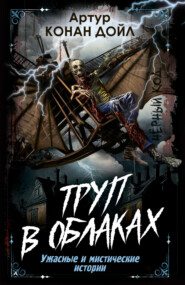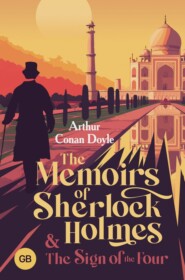По всем вопросам обращайтесь на: info@litportal.ru
(©) 2003-2024.
✖
The Memoirs of Sherlock Holmes
Автор
Год написания книги
2019
Настройки чтения
Размер шрифта
Высота строк
Поля
Arthur Conan Doyle was born in Edinburgh, Scotland, in 1859, the year Charles Darwin’s The Origin of Species was published. Conan Doyle was raised Catholic but declared himself agnostic by the time he began reading medicine at Edinburgh University, in 1876. He attained his doctorate in 1885, researching a condition caused by syphilis, known as tabes dorsalis, and characterised by the degeneration of sensory neurons causing the body to malfunction.
Conan Doyle’s professional life began with a stint as ship’s doctor on a voyage around the coast of west Africa. In early 1882, before his doctorate was complete, he set up a surgery in Plymouth, England, with a university friend. Unfortunately, their professional relationship was short-lived and Conan Doyle moved to Southsea, England, by that summer. He then established his own medical practice, but found that business was slow, so he worked on his writing, which he had enjoyed from an early age. By 1887, he had published his first Sherlock Holmes novel and steered his career in a different direction.
Between 1887 and 1927, Conan Doyle published nine Sherlock Holmes books: four novels and five collections of short stories. He wrote many other books, but Sherlock Holmes became such an iconic character that his other works were rather overshadowed. In fact, Conan Doyle made the decision to kill off Sherlock Holmes in 1894, in a short story entitled The Final Problem. There was such public outcry at the death of Sherlock Holmes that Conan Doyle was moved to bring him back to life in The Return of Sherlock Holmes.
Despite his agnosticism, Conan Doyle developed an interest in spiritualism, becoming fascinated by beliefs in supernatural phenomena, including the Cottingley Fairy photographs, now understood to be hoaxes. His obsession also created a rift between himself and his friend, escapologist Harry Houdini. Conan Doyle couldn’t accept that Houdini’s escapades were elaborate tricks and Houdini grew vexed at Conan Doyle’s insistence that he possessed magical powers.
Conan Doyle suffered from considerable personal tragedy in the early years of the 20th century. A number of family members died, including his wife Louise, in 1906, and his son Kingsley, in 1918. There was also the horror of World War I to contend with, which affected the entire nation’s morale.
The Influence of Science
One of Conan Doyle’s better-known other works is the science-fiction novel The Lost World, published in 1912. The character Professor Challenger mounts an expedition to the Amazon Basin. He and his entourage encounter all manner of prehistoric animals along the way and witness warfare between an indigenous tribe and ape-men. In context, this novel can be seen as a document of scientific inquiry at the time. The French science-fiction author Jules Verne had died six years before, leaving an anthology of similar stories, including Journey to the Centre of the Earth, 1864. Similarly, Conan Doyle’s contemporary, the English writer H. G. Wells, had published The Time Machine in 1895. These books all enabled the characters to visit other places in time and to witness extinct creatures brought back to life. This general theme proved popular in an era when fossils and the processes of evolution were beginning to be understood by science. Conan Doyle used science to underpin his literature, although it is fair to say that he allowed pseudoscience to also appear towards the end of his life. Sherlock Holmes was Conan Doyle’s expression of his recognition that the application of empirical science and acute intellect were the things that members of the British Empire saw as the reason for their success.
Sherlock Holmes
Arthur Conan Doyle originally invented and wrote about the character of Sherlock Holmes to fill his time during his period as a general practitioner. In 1887 came the first published appearance of Holmes, along with his faithful companion Dr Watson, in a novel entitled A Study in Scarlet. Then three years after that, in 1890, came his second, The Sign of Four.
These books established Conan Doyle as a successful author. The Adventures of Sherlock Holmes was published in 1892. Six of the twelve stories are described as ‘adventures’ in their title, because they were originally published singly in the Strand magazine and this provided a sense of continuity to the reader – a type of ‘product branding’. He had devised the detective mystery novel, considered a new genre at the time. Real-life crime cases were not usually very mysterious, but Conan Doyle recognised a need to elaborate for the sake of producing a good read. It is worth noting, however, that the case of the Whitehall Murders and Jack the Ripper had been prevalent in British newspapers in 1888, making the theme of mysterious crime-solving very topical. In fact, many of Conan Doyle’s fans wrote to him, suggesting that Sherlock Holmes attempt to solve the aforementioned crime. However, the author was wise enough to realise that there should be no crossover between fiction and fact, so Holmes was never called upon.
The private detective Sherlock Holmes was, in essence, a hybrid between the Victorian gentleman scientist and the police detective. The Victorian era marked an historical point where science came into its own as a distinct discipline based on empirical experimentation. Before then, science had been rather more ambiguous in its definition. Physicians, chemists and biologists had shown that the world always operates according to strict scientific rules and laws. It was this new phenomenon of scientific certainty that allowed Sherlock Holmes to confidently solve crimes in an age when police investigation was generally understood to be largely a matter of hit and miss, a mix of luck and judgement. Although a fictitious character, Holmes revolutionised the perception of what could be achieved by way of identifying and collecting evidence from crime scenes, theorising motives and courses of events and pinpointing suspects.
It suited the character development better for Holmes to be a private detective, as he evidently possessed a quality of intellectual genius which, so often, is accompanied by idiosyncrasies and eccentricities that make for a personality ill-suited to the routine and regulations of conventional employment.
To make Holmes believable as a character with an exceptional mind, he also needed to be flawed in certain ways, so the author made him something of a loner, with obsessive, fanatical and addictive traits. The result was a well-rounded character that the reader could understand, if not identify with, because he too had vulnerabilities and weaknesses common to us all. In fact, Conan Doyle openly admitted that the greatest part of Holmes was based on someone he knew: Professor Joseph Bell, a Scottish university lecturer and forensic pathologist. Conan Doyle had been impressed by the way Bell had implemented scientific analysis and detailed observation during post-mortem examinations in deducing the cause of death. Although commonplace now, a forensic approach was something quite new in 1877, when they first met.
Conan Doyle commented that Bell’s force of habit, or inculcation was one of observation, inference and deduction, so that the most likely cause of death was arrived at by a methodical process of elimination. It was a mindset of reason, logic and the application of acquired knowledge; perfect for a successful private investigator. The term Occam’s razor is sometimes applied to Holmes’ method, because it explains things by reducing, or razing, options so that assumptions and conclusions can be made with a reasonable level of accuracy and confidence.
At Sherlock Holmes’ side in all of his investigations is Dr John Watson, who acts as an enthusiastic deputy. He also narrates most of the Sherlock Holmes stories, so that the reader experiences events from a second-person perspective. Dr Watson is intelligent in his own right, but he admires Holmes for his ability to think about things on a higher plane. It is notable that Holmes has no letters before his name, because he is a free thinker and rejects the notion of establishment and official credentials.
Similarly, Holmes has a rather condescending view of those employed at Scotland Yard, the police headquarters in London. Inspector Lestrade is a Scotland Yard detective for whom Holmes has mixed feelings. On the one hand, he considers Lestrade the best detective on the force, but on the other hand, he seems to only tolerate him because Lestrade is useful and efficient at dealing with the more mundane duties of making arrests and providing manpower.
One notable characteristic of Sherlock Holmes is his penchant for dressing in disguise. Conan Doyle saw that it would be useful for Holmes to be a master of disguise, so that he could access situations without the requirement for assistants who might otherwise do the job for him. In effect, Holmes becomes another character while in disguise, thereby allowing him to glean vital information by stealth. In some ways, this was the forerunner to undercover police work, where detectives are expected to covertly gain the trust of criminals by pretending to be part of the gang or by observing from the sidelines. As a plot device, it was useful for Conan Doyle to have Holmes assume different disguises where necessary, to provide intelligence so that segue between elements of the investigation could be made.
Illustrations by Sidney Paget
When Arthur Conan Doyle’s stories were published in The Strand Magazine, each story was accompanied by a number of illustrations drawn by Sidney Paget (1860–1908). His drawings did much to popularize the Sherlock Holmes stories, and he established the familiar images of Holmes and Watson that have been adopted ever since in film and television. Holmes is portrayed as a tall and sophisticated type, well-presented and sartorially elegant. Watson is more ordinary and without distinction, resembling the common man more closely.
Paget was accidentally hired for the job, when the publishers addressed the commissioning letter to him rather than his brother. However, Conan Doyle was so impressed with his work that he insisted on using him for further stories. He died young, at the age of 48, but had by then illustrated 37 of the 56 Sherlock Holmes short stories and the novel The Hound of the Baskervilles. He drew 356 illustrations for Conan Doyle, and his style was identified so strongly with the detective stories that subsequent illustrators had to imitate it.
Sherlock Holmes’ deerstalker hat and Inverness cape were both introduced by Paget to give the character a more distinctive look, so that it was immediately obvious to the reader which figure was Holmes. Although Paget drew Holmes smoking a straight pipe, the famous curved calabash or briar pipe was introduced by an American actor named William Gillette, who portrayed Holmes on stage and in a very early silent film, in 1916. For many years it was thought that all copies of the film had been lost but, remarkably, a surviving copy was discovered in France in 2014.
The Memoirs of Sherlock Holmes
As with many of the Sherlock Holmes short stories, those in this collection were also originally published in The Strand Magazine between December 1892 and December 1893, and published together the following year. The collection contains twelve Sherlock Holmes mysteries, although one story – ‘The Adventure of the Cardboard Box’ – was excluded from the American edition because the theme of adultery was deemed inappropriate for the late-nineteenth-century readership.
SILVER BLAZE (#ucbdc8667-4b34-53ee-949a-adfbbd218b6e)
“I am afraid, Watson, that I shall have to go,” said Holmes, as we sat down together to our breakfast one morning.
“Go! Where to?”
“To Dartmoor; to King’s Pyland.”
I was not surprised. Indeed, my only wonder was that he had not already been mixed up in this extraordinary case, which was the one topic of conversation through the length and breadth of England. For a whole day my companion had rambled about the room with his chin upon his chest and his brows knitted, charging and recharging his pipe with the strongest black tobacco, and absolutely deaf to any of my questions or remarks. Fresh editions of every paper had been sent up by our news agent, only to be glanced over and tossed down into a corner. Yet, silent as he was, I knew perfectly well what it was over which he was brooding. There was but one problem before the public which could challenge his powers of analysis, and that was the singular disappearance of the favourite for the Wessex Cup, and the tragic murder of its trainer. When, therefore, he suddenly announced his intention of setting out for the scene of the drama it was only what I had both expected and hoped for.
“I should be most happy to go down with you if I should not be in the way,” said I.
“My dear Watson, you would confer a great favour upon me by coming. And I think that your time will not be misspent, for there are points about the case which promise to make it an absolutely unique one. We have, I think, just time to catch our train at Paddington, and I will go further into the matter upon our journey. You would oblige me by bringing with you your very excellent field-glass.”
And so it happened that an hour or so later I found myself in the corner of a first-class carriage flying along en route for Exeter, while Sherlock Holmes, with his sharp, eager face framed in his ear-flapped travelling-cap, dipped rapidly into the bundle of fresh papers which he had procured at Paddington. We had left Reading far behind us before he thrust the last one of them under the seat, and offered me his cigar-case.
“We are going well,” said he, looking out the window and glancing at his watch. “Our rate at present is fifty-three and a half miles an hour.”
“I have not observed the quarter-mile posts,” said I.
“Nor have I. But the telegraph posts upon this line are sixty yards apart, and the calculation is a simple one. I presume that you have looked into this matter of the murder of John Straker and the disappearance of Silver Blaze?”
“I have seen what the Telegraph and the Chronicle have to say.”
“It is one of those cases where the art of the reasoner should be used rather for the sifting of details than for the acquiring of fresh evidence. The tragedy has been so uncommon, so complete and of such personal importance to so many people, that we are suffering from a plethora of surmise, conjecture, and hypothesis. The difficulty is to detach the framework of fact—of absolute undeniable fact—from the embellishments of theorists and reporters. Then, having established ourselves upon this sound basis, it is our duty to see what inferences may be drawn and what are the special points upon which the whole mystery turns. On Tuesday evening I received telegrams from both Colonel Ross, the owner of the horse, and from Inspector Gregory, who is looking after the case, inviting my cooperation.
“Tuesday evening!” I exclaimed. “And this is Thursday morning. Why didn’t you go down yesterday?”
“Because I made a blunder, my dear Watson—which is, I am afraid, a more common occurrence than any one would think who only knew me through your memoirs. The fact is that I could not believe it possible that the most remarkable horse in England could long remain concealed, especially in so sparsely inhabited a place as the north of Dartmoor. From hour to hour yesterday I expected to hear that he had been found, and that his abductor was the murderer of John Straker. When, however, another morning had come, and I found that beyond the arrest of young Fitzroy Simpson nothing had been done, I felt that it was time for me to take action. Yet in some ways I feel that yesterday has not been wasted.”
“You have formed a theory, then?”
“At least I have got a grip of the essential facts of the case. I shall enumerate them to you, for nothing clears up a case so much as stating it to another person, and I can hardly expect your co-operation if I do not show you the position from which we start.”
I lay back against the cushions, puffing at my cigar, while Holmes, leaning forwardss, with his long, thin forefinger checking off the points upon the palm of his left hand, gave me a sketch of the events which had led to our journey.
“Silver Blaze,” said he, “is from the Somomy stock, and holds as brilliant a record as his famous ancestor. He is now in his fifth year, and has brought in turn each of the prizes of the turf to Colonel Ross, his fortunate owner. Up to the time of the catastrophe he was the first favourite for the Wessex Cup, the betting being three to one on him. He has always, however, been a prime favourite with the racing public, and has never yet disappointed them, so that even at those odds enormous sums of money have been laid upon him. It is obvious, therefore, that there were many people who had the strongest interest in preventing Silver Blaze from being there at the fall of the flag next Tuesday.
“The fact was, of course, appreciated at King’s Pyland, where the Colonel’s training-stable is situated. Every precaution was taken to guard the favourite. The trainer, John Straker, is a retired jockey who rode in Colonel Ross’s colours before he became too heavy for the weighing-chair. He has served the Colonel for five years as jockey and for seven as trainer, and has always shown himself to be a zealous and honest servant. Under him were three lads; for the establishment was a small one, containing only four horses in all. One of these lads sat up each night in the stable, while the others slept in the loft. All three bore excellent characters. John Straker, who is a married man, lived in a small villa about two hundred yards from the stables. He has no children, keeps one maid-servant, and is comfortably off. The country round is very lonely, but about half a mile to the north there is a small cluster of villas which have been built by a Tavistock contractor for the use of invalids and others who may wish to enjoy the pure Dartmoor air. Tavistock itself lies two miles to the west, while across the moor, also about two miles distant, is the larger training establishment of Mapleton, which belongs to Lord Backwater, and is managed by Silas Brown. In every other direction the moor is a complete wilderness, inhabited only by a few roaming gypsies. Such was the general situation last Monday night when the catastrophe occurred.
“On that evening the horses had been exercised and watered as usual, and the stables were locked up at nine o’clock. Two of the lads walked up to the trainer’s house, where they had supper in the kitchen, while the third, Ned Hunter, remained on guard. At a few minutes after nine the maid, Edith Baxter, carried down to the stables his supper, which consisted of a dish of curried mutton. She took no liquid, as there was a water-tap in the stables, and it was the rule that the lad on duty should drink nothing else. The maid carried a lantern with her, as it was very dark and the path ran across the open moor.
“Edith Baxter was within thirty yards of the stables, when a man appeared out of the darkness and called to her to stop. As he stepped into the circle of yellow light thrown by the lantern she saw that he was a person of gentlemanly bearing, dressed in a grey suit of tweeds, with a cloth cap. He wore gaiters, and carried a heavy stick with a knob to it. She was most impressed, however, by the extreme pallor of his face and by the nervousness of his manner. His age, she thought, would be rather over thirty than under it.
“‘Can you tell me where I am?’ he asked. ‘I had almost made up my mind to sleep on the moor, when I saw the light of your lantern.’
“‘You are close to the King’s Pyland training-stables,’ said she.
“‘Oh, indeed! What a stroke of luck!’ he cried. ‘I understand that a stable-boy sleeps there alone every night. Perhaps that is his supper which you are carrying to him. Now I am sure that you would not be too proud to earn the price of a new dress, would you?’ He took a piece of white paper folded up out of his waistcoat pocket. ‘See that the boy has this to-night, and you shall have the prettiest frock that money can buy.’
“She was frightened by the earnestness of his manner, and ran past him to the window through which she was accustomed to hand the meals. It was already opened, and Hunter was seated at the small table inside. She had begun to tell him of what had happened, when the stranger came up again.
“‘Good-evening,’ said he, looking through the window. ‘I wanted to have a word with you.’ The girl has sworn that as he spoke she noticed the corner of the little paper packet protruding from his closed hand.

















